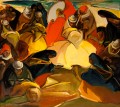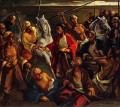Jonas Rimša
Biography
Jonas Rimša (Juan Rimsa) was born in 1903 in Svėdasai and grew up in Kaunas. Bowing to the will of his father, he graduated from the best sewing school in Vienna, and afterwards, completely focused on studying art, he went further abroad to search for his destiny elsewhere. In 1931–1934 he attended the Buenos Aires Academy of Art (Academia Nacional de Bellas Artes in Buenos Aires), which was the best institution of its kind in all of South America. In 1943, in the city of Sucre, the artist established an art school and was its director. However, one year later, the government needed to reduce its expenses and the school was forced to close. Unhindered, Rimša selected twenty-one of his most gifted students and established a private art school, the Curso Superior de Bellas Artes, which was in operation until 1951. In the art world, the students of this school became known as “Rimša’s Group”. He provided financial support to his students, and personally allocated funds to send more than a handful of talented Bolivian artists to pursue their studies in Europe – Graciela Rodo-Boulanger, Mario Eloy Vargas and Juan Ortega Leyton being among the most famous.
Jonas Rimša was honoured in the cultural sphere in Bolivia, being presented with the highest distinction given to civilians, the Cóndor de Los Andes award. He was also made a Honourary Citizen of Bolivia. The Bolivian Government acquired approximately 300 paintings from the artist and distributed them among the most significant national offices. The epic and impressive painting by Rimša, “The Founding of La Paz” (1948), is displayed in the Bolivian capital’s Municipal Hall. Several of his works also hang in the Central Bank in La Paz, as well as in the homes of private buyers.
The restless spirit of an adventurer encouraged Rimša to continue travelling and fine-tuning his craft. The artist lived in Argentina, Bolivia, the USA and Tahiti. Moving from one place to the next, he was able to burn his earlier works without feeling any remorse in his heart, and allowed himself to dream about the new, creative stage ahead of him. The artist spoke publicly about the breaking-point in his painting soon after he had turned fifty. He announced that he wished to paint differently, and stopped the monography already written about him from being published. He was a loner, and remarkably hard-working. The artist has painted close to 1,000 works and held over 30 solo exhibitions.
Style
Jonas Rimša is one of the most vivid artists of the Lithuanian diaspora to have promoted Lithuania abroad. Entertaining his interest in the ancient Inca civilization, he spent much time travelling through Argentina, Bolivia, Ecuador and Peru. At the core of Inca culture, the people of Cuzco also left a great impression on the artist, with their worn yet determined faces and colourful, ornamental clothing. The artist also had the opportunity to experience first-hand the deep, cultural traditions and language of the ancient people of the Aymara tribe of South American Indians who lived in the territory of Bolivia and Peru around Lake Titicaca. The painter, who had arrived from the low-lying shores of the northern Baltic Sea was captivated and inspired by the exotic nature of the former Incan Empire – a landscape of astoundingly high mountains rising from lush, jungle-filled valleys, forests and waterfalls, clouded in mist, as well as its history. The fact that the artist did not turn to abstractism, but learnt to love and respect the Indians, to acknowledge their ancient culture, the history of their land and its natural landscapes, has determined that Bolivians to this day treasure his creative legacy, and have named the artist “the missionary of art”. Jonas Rimša is considered among the most influential Bolivian painters.
2012 © VšĮ „Lietuvos išeivijos dailės fondas“, A.Tumėno g. 4, VilniusE: info@iseivijosdaile.lt P: +370 5 2644741 F: +370 5 2644742






